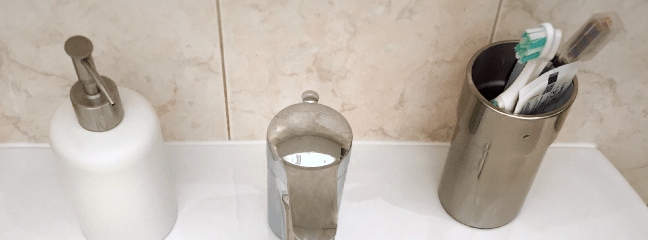It’s hard to tell exactly which is the germiest room in the house. The bathroom? The kitchen? An independent health organization called NSF International conducted a study on this. They noted where they thought the most germs in a household were hiding, and where they actually were.
They looked for these bacteria:
- Coliform (a family of bacteria that includes Salmonella and E.coli)
- Staph Aureus
- Yeast/mold
27% of the homes surveyed had Coliform, a signal of fecal contamination, and it was on the toothbrush holders!
The inside of your toothbrush holder is a little-known germ breeding ground. Twice a day or more, your soggy toothbrush reenters the toothbrush holder.
Old germs at the bottom of the container scrape the toothbrush, smearing contamination all over. With its dark, damp inside, it’s no wonder 64% of toothbrush holders carry yeast and mold.
If possible, we recommend brushing at least 6 feet away from your toilet. It’s easier to manage germs on and around your toothbrush when you’re aware of germ hiding places like these.
DENTAL DO’S:
Use your own toothbrush holders – don’t share!
Brush only at the sink. Shower water can spread germs from the showerhead to your mouth.
Wash your hands before brushing.
Brush for TWO minutes with toothpaste.
Rinse your toothbrush to remove food debris.
Dry handle and bristles and store in a dry, clean area.
DENTAL DON’TS:
Don’t store your brush in a closed cap or container. Bacteria love it in there!
Never microwave your toothbrush to clean it. It doesn’t disinfect it. We recommend purchasing a new one, instead.
Never share your toothbrush with peers or children. Transferring foreign germs is never good.
You’ll also want to replace your toothbrush if:
- Your toothbrush bristles are fraying.
- You’ve been sick.
- It’s been 3 months since your last toothbrush replacement.


